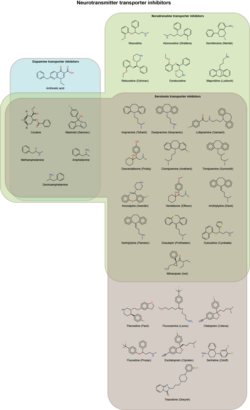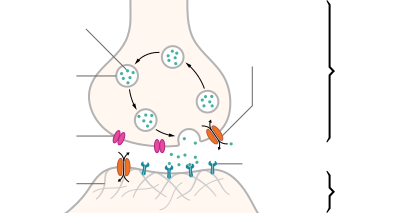Neurotransmitter transporter
Neurotransmitter transporters are a class of
Vesicular transporters move neurotransmitters into
Neurotransmitter transporters frequently use
Normally, transporters in the synaptic membrane serve to remove neurotransmitters from the synaptic cleft and prevent their action or bring it to an end. However, on occasion transporters can work in reverse, transporting neurotransmitters into the synapse, allowing these neurotransmitters to bind to their receptors and exert their effect. This "nonvesicular release" of neurotransmitters is used by some cells, such as amacrine cells in the retina, as a normal form of neurotransmitter release.[5]
Types
Specific types of neurotransmitter transporters include the following:
- Glutamate/aspartate transporters, including:
- Excitatory amino acid transporter 1(EAAT1)
- Excitatory amino acid transporter 2(EAAT2)
- Excitatory amino acid transporter 3(EAAT3)
- Excitatory amino acid transporter 4(EAAT4)
- Excitatory amino acid transporter 5(EAAT5)
- Vesicular glutamate transporter 1 (VGLUT1)
- Vesicular glutamate transporter 2 (VGLUT2)
- Vesicular glutamate transporter 3 (VGLUT3)
- GABA transporters, including:
- GABA transporter type 1 (GAT1)
- GABA transporter type 2 (GAT2)
- GABA transporter type 3 (GAT3)
- Betaine transporter (BGT1)
- Vesicular GABA transporter(VGAT)
- Glycine transporters, including:
- Glycine transporter type 1(GlyT1)
- Glycine transporter type 2(GlyT2)
- Monoamine transporters, including:
- Dopamine transporter (DAT)
- Norepinephrine transporter (NET)
- Serotonin transporter (SERT)
- Vesicular monoamine transporter 1 (VMAT1)
- Vesicular monoamine transporter 2 (VMAT2)
- Adenosine transporters, including:
- Equilibrative nucleoside transporter 1 (ENT1)
- Equilibrative nucleoside transporter 2 (ENT2)
- Equilibrative nucleoside transporter 3 (ENT3)
- Equilibrative nucleoside transporter 4(ENT4)
- Vesicular acetylcholine transporter (VAChT)[6]
Note that there is no plasmalemmal acetylcholine transporter, as acetylcholine is terminated via rapid metabolism into choline by cholinesterase enzymes, and choline is subsequently transported back into the cell and reconverted into acetylcholine.
Transporters associated with
Clinical significance
A variety of neurotransmitter reuptake transporters are pharmacotherapeutic targets for modulating the synaptic neurotransmitter concentration, and therefore neurotransmission.
- synaptic cleft.
- Psychostimulants like cocaine, amphetamines, and methylphenidate act by inhibiting and/or reversing the dopamine and/or norepinephrine transporters. Some dissociatives like phencyclidine and ketamineare also dopamine transporter inhibitors.
- Tiagabine, a drug used as an anticonvulsant, acts by inhibiting the GABA transporter 1.

Vesicular transporters could provide an alternative therapeutic target for the modulation of chemical neurotransmission, as the activity of these transporters could affect the quantity of neurotransmitter released.[7]
- Vesamicol, for example, is an inhibitor of the vesicular acetylcholine transporter. It prevents the loading of ACh into the presynaptic vesicles, causing a fall in the amount that is released in response to a neuronal action potential. It is not used clinically, but provides a useful tool for research into the behaviour of neurotransmitter vesicles.[8]
References
External links
- Neurotransmitter+Transporters at the U.S. National Library of Medicine Medical Subject Headings (MeSH)
- Clearing Your Mind of Neurotransmitters: Functional Impact of Neurotransmitter Transporter Gene Variants - a videocast of the lecture by Randy Blakely, Ph.D., .m4vformat.
- The Blakely Lab - Laboratory exploring the molecular basis for neurotransmitter transporter structure, function and regulation.

